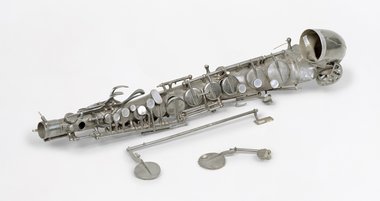John Hurrell – 13 August, 2020
Much pleasure is to be gained by moving around the open floor space of the North Atrium to explore each of the six speakers, examining Philipsz's sonic layering, overlapping and sequencing of pieces of chordal progression. Each speaker seems to have its own array of contributors; with different frequencies and timbres. Fragmented musical sections are chronologically spread out, beginning and ending unpredictably. The whole piece starts faintly in the distance and gradually builds up, slowly gaining in volume—though never too strident.
Auckland
Susan Philipsz
War Damaged Musical Instruments (2015)
Nathan Coley
A Place Beyond Belief (2012)
Curated by Juliana Engberg
10 July - 22 November 20202 (prelockdown dates)
There is considerable pathos in Susan Philipsz making musical art from instruments mutilated by warfare—smashed up tools like the bodies of the hapless musicians who played them—found in the mud and gore of battle, and then resurrected and partially repaired to be played by brass music enthusiasts, and recorded.
The piecemeal instruments came from military museums that examine various armed conflicts (within the last 200 years) between England and Germany. Philipsz’s fourteen minute long recording of spliced together playings from retrieved battered metal casualties, is emitted from two high rows of three spaced apart speakers in the North Atrium—starting every hour. It is wonderful experience, a long (very poignant, slightly mangled) version of The Last Post.
Much pleasure is to be gained by moving around the open floor space to explore each of the six speakers, examining Philipsz’s sonic layering, overlapping and sequencing of pieces of chordal progression. Each speaker seems to have its own array of contributors; with different frequencies and timbres. Fragmented musical sections are chronologically spread out, beginning and ending unpredictably.
The whole piece starts faintly in the distance and gradually builds up, slowly gaining in volume—though never too strident. It seems to stop and start in an ad hoc fashion, like a rubberband that could snap. The haunting melody just hangs in there in a recognisable fashion.
There are basically three types of instrument: The brass or wooden types with reeds in their mouthpieces, like saxophones and clarinets. The classic military brass instruments with mouthpieces that use lip vibrations (embouchure)—trumpets, tubas, cornets, flugelhorns, ophicleides and bugles. Plus there is also a glass piccolo where the blowing of air is more indirect-across the hole-to make a high pitched, delicate, vibrating sound. Rather like the circular rim of a glass being rubbed with a wet finger.
This wonderful work was gifted to the collection of Auckland Art Gallery Toi o Tamaki by the Friends of Auckland Art Gallery, and seems a little influenced in its choice of damaged materials by Cornelia Parker’s 2001 work Breathless. Parker though is more than a pinch mischievous in her organising of brass instruments to be flattened by a steamroller, before they are installed suspended in a gallery. Philipsz is the opposite, focussing on a kind of healing or mending. She is making a sort of auditory poultice or balm, giving pieces of mutilated instruments a second life-creating something beautiful and stirring out of tragedy.
In the North Atrium Juliana Engberg (AAG’s global contemporary art curator) seems to have deliberately positioned Philipsz’ sound work directly in front of Nathan Coley‘s already installed, lettered, construction on a scaffold, and I was shocked that an experienced curator would do such a thing, despite one work being visual and the other aural. It can’t be accidental so it must be calculated. (Engberg has written excellent essays on both.) I imagine her unstated intention is that the evocative meanings of both merge (or overlap like intersecting shadows from spatially opposing light sources).
Nathan Coley’s text work, A Place Beyond Belief, exploits illuminating fairylights that delineate its letters. It presents a phrase overheard by Coley on American radio a week after the Twin Towers attack had occurred, when a woman was describing a racist incident where a Sikh man on a subway train was being put in a stressful situation by hostile and ignorant passagers. She spoke the four words when thinking of New York as needing to be a zone free from religious antagonism.
Recontextualised in Auckland in a depository for art objects, but installed within an unexpected juxtaposition, it now refers to a kind of sanctuary far from the carnage of warfare referenced by Philipsz’ mournful music, a space free from the violence generated by fiercely clashing ideological opinions. A third mental space—a sort of conceptual vesica piscis of meaning from two overlapping circles with the same measured radius—is created.
Initially I was irritated by the jamming together—the wilfully tight juxtaposition—but I can see Engberg’s wit, the respective contexts of savage destruction (almost a hundred years apart) now merging.
John Hurrell

 Advertising in this column
Advertising in this column Two Rooms presents a program of residencies and projects
Two Rooms presents a program of residencies and projects



This Discussion has 0 comments.
Comment
Participate
Register to Participate.
Sign in
Sign in to an existing account.